|
|
Dear Colleagues,
As PSI, science and some of our nations take the first tentative steps to opening up, a phrase that has been used a lot is moving towards the new normal. But as the Head of Science IT at PSI I am only too aware that in a dynamic and evolving world of large-scale facilities, normal is always new as we continue to evolve and adapt to get more from our data and our instruments.
|

Alun Ashton
|
|
During the current pandemic the Science IT section have, like many, been supporting and developing services that meet the current needs of SLS as it maintains operations especially for remote access; developments for SwissFEL; and working with colleagues in other departments to both improve and enable their remote science and analysis.
Working and collaborating remotely will inevitably be a more prominent part of our profession, if not for bio-security but for environmental considerations. Through a number of national initiatives with partners such as CSCS and SDSC, and as co-lead of the ExPaNDS EU project of 10 national facilities, PSI hopes to facilitate remote access to data processing services and open data further. As a prelude to this there are already an increasing amount of data published as we expand our capabilities to meet the PSI Data Policy.
Alun Ashton
On behalf of the Science IT section, Logistics division
|
|
Impact of COVID-19 on user operation at PSI
The SLS remained in user operation throughout the pandemic, albeit without external users and less than 20% staff on site. PSI staff and you as our users took great efforts to realize research projects via remote access and mail-in of samples to be measured by PSI staff for you. It has been impressive to witness the excellent team spirit and motivation in times of social distancing.
|
 courtesy of imago images / Science Photo Library courtesy of imago images / Science Photo Library
|
|
|
Since June 5, external SLS users are allowed on site and the guesthouse reopened. Persons with right of free movement - in particular from Schengen states - are now allowed to enter Switzerland subject to the customary requirements. For third-country nationals who do not have rights of free movement, entry restrictions continue to apply. The safety concept for our users relies on proven measures like distance keeping in combination with reduced numbers of persons on site. Fully remote controlled or mixed remote/local experiments are becoming the new standard. The rapid access call for COVID-19 research has been very successful (see below) and is open until September.
As you know, the situation is moving fast and is hardly predictable. We will try to keep you informed. Please visit the User Office Homepage for the latest updates.
|
|
Next proposal submission deadlines:
SLS: non-PX beamlines
deadline: September 15, 2020
more information
SwissFEL
deadline: September 15, 2020
more information
SLS: PX beamlines
deadline: October 15, 2020
more information
SINQ
deadline: November 15, 2020 (tbc)
more information
SµS
deadline: December 2020 (tbc)
more information
Particle Physics
deadline: January 11, 2021
more information
An overview of all proposal submission deadlines of the PSI facilities can be found here.
|
|
|
First MX results of the priority COVID-19 call
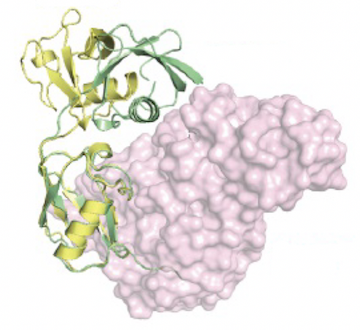 SLS - Elucidating structural and mechanistic aspects of SARS-CoV-2 infection SLS - Elucidating structural and mechanistic aspects of SARS-CoV-2 infection
Scientists from the Goethe University Frankfurt have published the first MX results of our priority COVID-19 call. Working - remotely - at the macromolecular crystallography beamline X06SA-PXI of SLS, they studied papain-like protease (PLpro), an essential enzyme of the SARS-CoV-2 coronavirus. The crystallographic-data collection happened on 9 April, as the planned Easter shutdown of SLS was cancelled for this specific experiment. PLpro is required for the processing of viral polypeptides and the assembly of new viral particles within human cells. The researchers have demonstrated that pharmaceutical targeting of PLpro by a specific non-covalent inhibitor blocks virus spread and increases anti-viral immunity in human epithelial cells, the prime site of pathogen entry. The paper reporting these results was submitted within one month of answering the priority COVID-19 call.
Read the full story
|
|
Stroboscopic neutron diffraction applied to fast time-resolved operando studies on Li-ion batteries
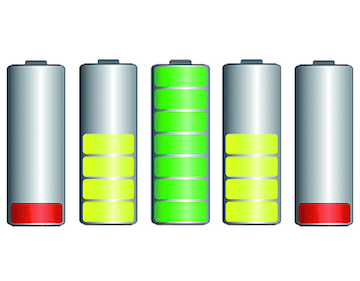
SINQ - Batteries under the neutron stroboscope
With the first application of stroboscopic neutron diffraction to studying lithium-ion batteries during operation, PSI scientists, in collaboration with colleagues at the Université Grenoble Alpes and an industrial partner, have established a new approach to unravelling the complex processes playing out in energy-storage materials. Neutron diffraction has long been recognised as a powerful modality for monitoring structural modifications of individual battery components. However, during fast charging and discharging, there is typically not enough time to acquire sufficient data for extracting structural information about intermediate states. Working at the HRPT diffractometer of SINQ, the team has now demonstrated that with a stroboscopic technique - whereby the same stage of a periodic process is sampled over several iterations - they can obtain appropriate statistics to characterise short-lived states during fast cycling.
Read the full story
|
|
|
D. Sheptyakov et al., J. Mater. Chem. A 8, 1288 (2020)
|
|
|
Reversible spin storage in metal oxide–fullerene heterojunctions
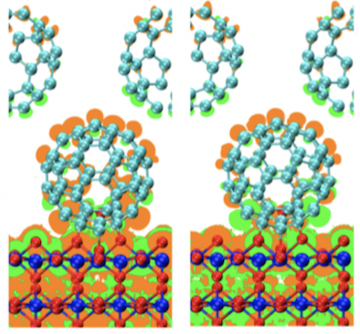
SμS - Realisation of a 'spin capacitor'
An international team led by scientists from Leeds University has demonstrated a path to generating spin-polarized charges and storing them for up to hours at room temperature. They show that hybrid devices incorporating interfaces at which C60 molecules hybridise with manganese-oxide surfaces can be charged with a magnetic electrode and subsequently store spin polarization in stable, localized states. By combining X-ray absorption spectroscopy data, obtained at the ALBA synchrotron near Barcelona, low-energy muon spin rotation measurements performed at PSI and DFT calculations, the researchers establish that an interplay between stray fields, spin-polarized interfacial dipole formation and interface-limited transport facilitates spin-dependent trapping of optically or electrically generated charges for periods long enough to be of interest for practical applications.
Read the full story
|
|
|
T. Moorsom et al., Science Advances 6, eaax1085 (2020)
|
|
|
Femtosecond-to-millisecond structural changes in a light-driven sodium pump
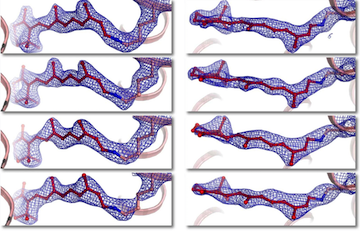 SwissFEL - A molecular action movie SwissFEL - A molecular action movie
High-resolution snapshots throughout the photocycle of a light-driven sodium pump, obtained at SwissFEL, provide unique insight into the structural changes associated with active transport of sodium ions across biological membranes. An international collaboration led by PSI researchers studied the structural evolution in the prototypical sodium pump Krokinobacter eikastus rhodopsin 2 (KR2), covering a wide temporal window from 800 fs to 20 ms after activation. With these snapshots they assembled the first molecular movie of structural changes in KR2 ‘in action’ and, combined with spectroscopic data and quantum chemical calculations, propose a basic mechanistic model of light-driven sodium transport. The importance of these findings might extend to applications, in particular for the further development of optogenetic tools for neuroscience.
Read the full story |
|
|
P. Skopintsev et al., Nature, 20 May 2020 (online)
|
|
|
Laser spectroscopy of pionic helium atoms
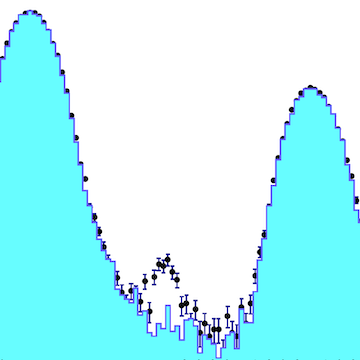 Particle Physics - Laser focus on mesons Particle Physics - Laser focus on mesons
At the πE5 beamline of PSI's 590-MeV ring cyclotron, a collaboration of researchers from the Max Planck Institute of Quantum Optics in Garching, PSI and CERN has achieved the first demonstration of laser spectroscopy of a meson. Working with pionic helium - consisting of an α particle, an electron, and a π−meson - and having at their disposal the pion source with the worldwide highest average intensity, the team has overcome two key obstacles limiting so far high-precision studies of pionic atoms: their short lifetime and challenges associated with producing them in sufficiently high numbers. With the successful observation of direct spectroscopic signatures from π4He+, the existence of a metastable state in this exotic atom is now verified, and fresh opportunities are awaiting for probing fundamental physics with mesons.
Read the full story
|
|
|
M. Hori et al., Nature 581, 37 (2020)
|
|
|
SLS returned to normal 24/7 operation
SLS
During the whole COVID-19 crisis the SLS was in 'user operation without users on site'. Until the end of May SLS was operational in 24/5 mode and since June 5 we resumed normal 24/7 operation mode with users on campus. For the MX community we operate the three SLS MX beamlines in 100% remote mode and we cover Dewar shipping costs for European academic users (due to the present situation, delivery delays are expected).
|
|
Welcome back
SINQ
The corona pandemic reached Switzerland in spring, exactly when the major neutron guide upgrade program of the Swiss neutron source SINQ was on the home straight. Thanks to the extraordinarily professional and dedicated efforts of both PSI and external staff, the most critical milestone - the installation of the new neutron guides - was nevertheless completed according to schedule. The remaining work to conclude the upgrade is currently being finalized with minimum delays.
During the first proposal round, we received more than 200 new proposals distributed across currently 9 available instruments (with the remaining instruments following suite soon), asking for a total of more than 900 beam days. This impressively highlights the continuing need for neutrons at PSI and we are looking forward to resuming SINQ operation by the end of July and to welcoming external users starting from September 1.
|
|
New experimental schedule due to corona crisis
SμS
Due to the corona crisis, the restart of operation of the PSI high intensity proton accelerator (HIPA) has been delayed. It is expected now for July 13. The pandemic team of PSI approved in-house research at the SµS from this date on. According to the current situation, external/foreign users at the SµS will be allowed starting from September 1. In the coming days, a new experimental schedule will be published.
We have shifted the approved experiments of foreign users to a date as late as possible in the year and we assume that those users will be able to conduct their experiments at PSI. However, for all experiments foreign travel restrictions and entry requirements into Switzerland and PSI need to be carefully considered. Some experiments (especially for DOLLY) had to be scheduled before September 1. For these experiments and for those where travel restrictions prevent travelling to PSI, the PSI team offers to conduct the experiments for the users. For experiments that cannot be conducted in this way, it might be possible to shift the beamtime to next year.
|
|
First light at ATHOS
SwissFEL
The ATHOS team at SwissFEL has reached a further milestone. On June 24 the soft X-ray FEL beam passed down the beamline to the experimental hutch, where it was detected on a photon screen a few meters before the experimental chamber. The measured pulse energy was 180 µJ at 35 Å (357 eV). Six undulators were in operation, producing circularly polarized light contributing to the lasing. The next target for the photon beam is the experimental chamber of the Maloja endstation.
|
|
New design for the muon production target TgE
Particle Physics and Large Research Facilities
Surface muons - the workhorse of muon experiments at PSI - are created by the decay of pions stopped very close to the surface of the production target. As such, their yield is strongly affected by the target geometry. In an extensive study, as part of the High-intensity Muon Beam project (HiMB), we have found that slanting the graphite target at an angle of a few degrees allows the overall surface area of the target to be enlarged (while keeping the interaction length with the protons constant) thereby increasing the yield of surface muons by 40-50% depending on beamline. The new target was successfully tested during the last 3.5 weeks of operation at the 590 MeV proton accelerator HIPA in 2019 and the increased yields were confirmed by measurements in the experimental areas. The new target will also be installed this year in order to benefit from the increased surface muon yields and test its long-term performance.
|
|
JUSAP - The Joint Users Association
Dear colleagues,
At the time of publication of the previous PSI newsletter in March, the situation regarding the evolution of COVID-19 was very worrying. We were facing a new danger in Europe and each country had to respond quickly by adopting a clear and efficient strategy to save lives and contain the propagation of the virus.
|
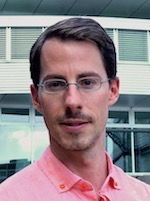
Claude Monney
|
|
Three months later, we are happy to see that the partial lockdown adopted by Switzerland has been succesful in this respect. As a consequence, operation with external users at the large-scale facilities of PSI is gradually restarting. See the User Office Homepage for more information. We continue to watch the evolving situation worldwide and send our best wishes to our international community.
During that period, the 13th ESUO annual meeting was initially scheduled on April 16-17, 2020 at DESY and European XFEL. Due to the developing situation with respect to the spread of COVID-19, the present meeting, in agreement with the local hosting teams, was postponed to a later date and a remote meeting was offered on April 16-17, 2020. ESUO delegates from 25 ESUO member countries, together with participants from the CALIPSOplus project - including colleagues from the CALIPSOplus Networking Activities (NA1) and Joint Research activities (JRA2) teams - as well as from the League of European Accelerator-based Photon Sources (LEAPS) and the industrial sector (partially) took part to the ESUO webinar. A short report about the ESUO webinar can be found here.
Finally, three months ago, we advertised the newly funded Swiss Society for Photon Science (SSPh). Its mission is to represent scientists active in the fields of optics, photonics and spectroscopy. It is important that you, as a present or future photon user in Switzerland, support the SSPh by becoming a member as soon as possible! Please register here.
We encourage you, members of the PSI user community, to communicate to us any issues, concerns or suggestions. In this case, please contact us, committee members, directly.
Yours sincerely,
Claude Monney and Annick Froideval on behalf of the JUSAP committee
|
|
|
|